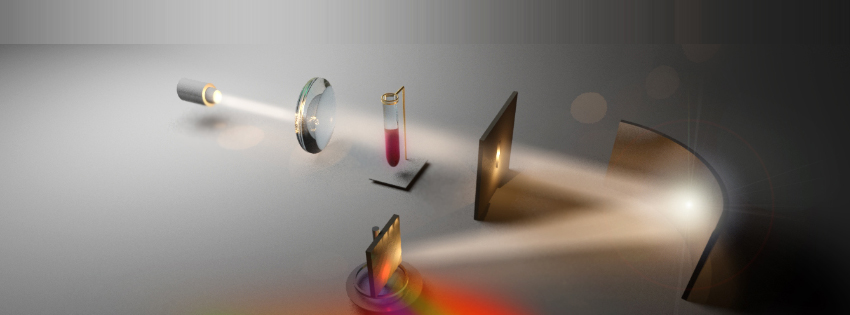The Slit
Once light has interacted with the material under test and has been collected by the lenses within the interrogation module, the light is then passed through a narrow vertical slit. The width of the slit is one of the main parameters that determine the resolution of the spectrometer and the amount of light that is able to enter the spectrometer for processing. A larger width will increase the optical power available for analysis, which can reduce the time needed to acquire an accurate reading, but will increase the minimum difference in wavelength that can be resolved by the spectrometer. It is therefore very important to choose the correct slit width for the needs of a given application.
Slits are available in a wide range of widths, ranging from 5 µm up to a maximum of 800 µm, and are typically between 1 mm and 2 mm in height, with a 1 mm height being the standard. The slit must be placed very accurately within the optical path of the spectrometer due to its very small size, otherwise the optical power throughput and the calibration of the spectrometer will be greatly compromised. Therefore, once a slit is selected it is permanently mounted within the spectrometer and should only be changed by a trained technician. This increases the importance of your choice of slit width, since it will be difficult and costly to install a new slit once the spectrometer has been assembled.
Throughput
The slit determines the throughput of the optical system by blocking some percentage of the optical power collected by the optical systems of the interrogation module. The throughput is limited both the open aperture area of the slit (width x height) and the spatial distribution of the optical power at the output plane of the interrogation module optics. For a well-designed lens system, the focal spot formed by the system is usually circularly symmetric. A geometric mismatch between the slit and the output of the lens exists, especially for thinner slits that are very narrow rectangles. Unless the width of the focal spot is equal to or smaller than the width of the slit, some of the optical power will be blocked from entering the spectrometer. The less optical power available to the spectrometer, the longer the time required to collect enough power from the sample to make an accurate measurement of the wavelength. Some fiber coupled systems use a ribbon fiber – with the fibers laid out in a line similar to an electrical ribbon cable – so that the light from the fiber has the same geometry as the slit, which increases the potential optical throughput. The widest possible slit width that satisfies the resolution requirements should be used to maximize throughput.
Resolution
The primary function of the entrance slit is to control the resolution of the spectrometer. This function has two components – restricting the angle of the light entering the train of optical components within the spectrometer and controlling the width of the light beam striking the DMD.
As the width of the slit decreases, more and more of the light traveling at large angle to the optical axis – the central axis of symmetry of the optical processing system – are blocked by the slit. The remaining light rays are highly paraxial – parallel to the optical axis – which significantly reduces distortions in the images formed by the focusing optics. Sharper, more rectangular images of the slit increase the ability of the DMD to distinctly separate groups of wavelengths for processing by the detector, and thus increase the resolving power of the instrument.
The entrance slit acts as the input object for the optical systems within the spectrometer. The focusing elements before the grating and before the DMD have a total magnification, M, that controls the width of the final image (Wi ) on the DMD according to:
where Ws is the width of the entrance slit and Wo is additional image broadening due to the design of the optical processing system. Wo is larger (up to a few tens of microns) when using off-axis components, such as in a Czerny-Turner configuration, that increase image aberrations. An on-axis optical train, such as that used in the Nano, results in smaller Wo, giving more control of the resolution to the slit width.
The resolution of the instrument is then determined by the relative sizes of Wi and the width of the DMD mirrors WM, plus the distance dλ between wavelengths produced the diffraction grating. Figure S-1 depicts the relationship between the three parameters. If Wi is too large for the available dλ, the images formed by different wavelengths can overlap, causing uncertainty about which point in space corresponds to which wavelength and thus reducing the ability of the spectrometer to uniquely resolve closely space wavelengths. The minimum resolution of the spectrometer is increased as a result. The problem can be solved by increasing dλ instead of decreasing WS, but as will be discussed in other sections this decreases the total range of wavelengths the spectrometer can make measurements on. When Wi is close to or less than dλ for two given wavelengths the two images become more distinct, and the spectrometer can resolve more closely spaced wavelengths. Decreasing Wi below the mirror width WM does not provide any benefit, because a dλ < WM results in two wavelengths that have been separated by the grating being simultaneously directed to the detector by the same mirror, effectively recombining them and negating the separation effect of the grating.


